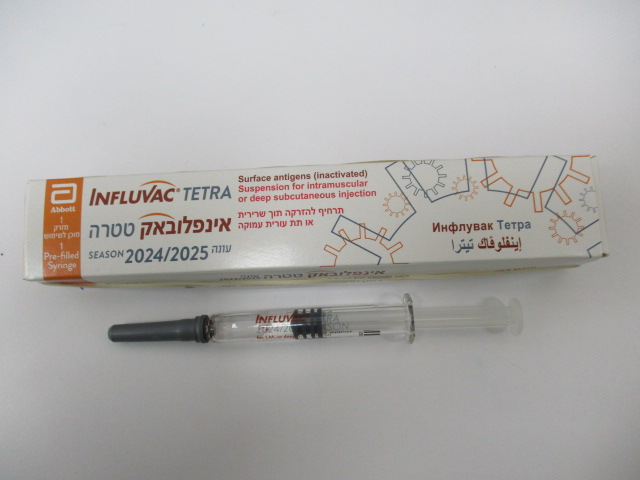Quest for the right Drug

אינפלובאק טטרה INFLUVAC TETRA (A/DARWIN/9/2021 (H3N2)-LIKE VIRUS, A/THAILAND/8/2022 (H3N2)-LIKE VIRUS, A/VICTORIA/2570/2019 (H1N1)PDM09-LIKE VIRUS, A/VICTORIA/4897/2022 (H1N1)PDM09-LIKE VIRUS, B/AUSTRIA/1359417/2021 (B/VICTORIA LINEAGE)-LIKE VIRUS, B/PHUKET/3073/2013 (B/YAMAGATA LINEAGE)-LIKE VIRUS)
תרופה במרשם
תרופה בסל
נרקוטיקה
ציטוטוקסיקה
צורת מתן:
תת-עורי, תוך-שרירי : S.C, I.M
צורת מינון:
תרחיף להזרקה : SUSPENSION FOR INJECTION
עלון לרופא
מינוניםPosology התוויות
Indications תופעות לוואי
Adverse reactions התוויות נגד
Contraindications אינטראקציות
Interactions מינון יתר
Overdose הריון/הנקה
Pregnancy & Lactation אוכלוסיות מיוחדות
Special populations תכונות פרמקולוגיות
Pharmacological properties מידע רוקחי
Pharmaceutical particulars אזהרת שימוש
Special Warning עלון לרופא
Physicians Leaflet
Adverse reactions : תופעות לוואי
4.8. Undesirable effects a. Summary of the safety profile The safety of Influvac Tetra was assessed in three clinical trials. In two clinical studies, healthy adults 18 years of age and older, and healthy children 3 to 17 years of age were administered Influvac Tetra or trivalent influenza vaccine Influvac. In a third study, the safety of Influvac Tetra was assessed in healthy children from 6 months to 35 months of age administered Influvac Tetra or a non-influenza vaccine control. In both children studies, children from 6 months to 8 years of age received one or two doses of Influvac Tetra depending on their influenza vaccination history. Most reactions usually occurred within the first 3 days following vaccination and resolved spontaneously within 1 to 3 days after onset. The intensity of these reactions was generally mild. In all age groups, the most frequently reported local adverse reaction after vaccination observed in the clinical studies for Influvac Tetra was vaccination site pain. The most frequently reported general adverse reactions after vaccination observed in the clinical studies for Influvac Tetra in adults and children from 6 to 17 years of age were fatigue and headache, and for children from 3 to 5 years of age drowsiness, irritability and loss of appetite. The most frequently reported general adverse reactions after vaccination observed in the clinical studies for Influvac Tetra in children from 6 months to 35 months of age were irritability/fussiness. Similar rates of solicited adverse reactions were observed in recipients of Influvac Tetra and trivalent influenza vaccine Influvac. The rates of solicited systemic adverse reactions were similar in recipients of Influvac Tetra and the non-influenza vaccine, whereby the rates of solicited local adverse reactions were lower in recipients of Influvac Tetra. b. Tabulated summary of adverse reactions The following undesirable effects are considered at least possibly related to Influvac Tetra and have either been observed during the clinical trials with Influvac Tetra or are resulting from post-marketing experience with Influvac Tetra and/or the trivalent influenza vaccine Influvac. The following frequencies apply: very common (≥1/10); common (≥1/100, <1/10); uncommon (≥1/1,000, <1/100); and not known (adverse reactions from post-marketing experience; cannot be estimated from the available data). Adults and elderly Adverse Reactions Reported with Influvac Tetra Not Knowna MedDRA System Very common Common Uncommon (cannot be estimated Organ Class ≥ 1/10 ≥ 1/100 to < 1/10 ≥ 1/1,000 to < 1/100 from the available data) Blood and lymphatic Transient system thrombocytopenia, transient lymphadenopathy Allergic reactions, in rare Immune system cases leading to shock, disorders angioedema Nervous system Headacheb Neuralgia, paraesthesia, disorders febrile convulsions, neurological disorders, such as encephalomyelitis, neuritis and Guillain Barré syndrome Vasculitis associated in very rare cases with Vascular disorders transient renal involvement Skin and Sweating Generalised skin reactions subcutaneous tissue including pruritus, disorders urticaria or non-specific rash Musculoskeletal and Myalgia, connective tissue arthralgia disorders General disorders Fatigue Malaise, shivering Fever and administration Local reaction: Local reactions: site conditions pain redness, swelling, ecchymosis, induration a Because these reactions are reported voluntarily from a population of uncertain size, it is not possible to reliably estimate their frequency or establish a causal relationship to drug exposure. b In elderly adults (≥ 61 years) reported as common Paediatric population Children (6 months to 17 years of age) Adverse Reactions Reported with Influvac Tetra Uncommon Not Knowna MedDRA System Very common Common ≥ 1/1,000 to (cannot be estimated Organ Class ≥ 1/10 ≥ 1/100 to < 1/10 < 1/100 from the available data) Blood and lymphatic Transient system thrombocytopenia, transient lymphadenopathy Allergic reactions, in rare Immune system cases leading to shock, disorders angioedema Nervous system Headachec Neuralgia, paraesthesia, disorders Drowsinessb febrile convulsions, neurological disorders, such as encephalomyelitis, neuritis and Guillain Barré syndrome Vasculitis associated in very rare cases with Vascular disorders transient renal involvement Skin and Sweatingf Generalised skin reactions subcutaneous tissue including pruritus, disorders urticaria or non-specific rash Metabolism and Appetite lossb nutrition disorders Gastrointestinal Nauseac, abdominal disorders painc, diarrhoeae, vomitinge Psychiatric disorders Irritability/fussinessb Musculoskeletal and Myalgiac Arthralgiac connective tissue disorders General disorders Fatiguec, feverf Shiveringc c and administration malaise Local reaction: site conditions Local reactions: pain, ecchymosis redness, swellingd, indurationd a Because these reactions are reported voluntarily from a population of uncertain size, it is not possible to reliably estimate their frequency or establish a causal relationship to drug exposure b Reported in children 6 months to 5 years of age c Reported in children 6 to 17 years of age d Reported as common in children 6 to 35 months of age e Reported as common in children 3 to 5 years of age f Reported as common in children 3 to 17 years of age Reporting of suspected adverse reactions Reporting suspected adverse reactions after authorisation of the medicinal product is important. It allows continued monitoring of the benefit/risk balance of the medicinal product. Any suspected adverse events should be reported to the Ministry of Health according to the National Regulation by using an online form http://forms.gov.il/globaldata/getsequence/getsequence.aspx?formType=AdversEffectMedic@moh.g ov.il

שימוש לפי פנקס קופ''ח כללית 1994
לא צוין
תאריך הכללה מקורי בסל
לא צוין
הגבלות
לא צוין
מידע נוסף
